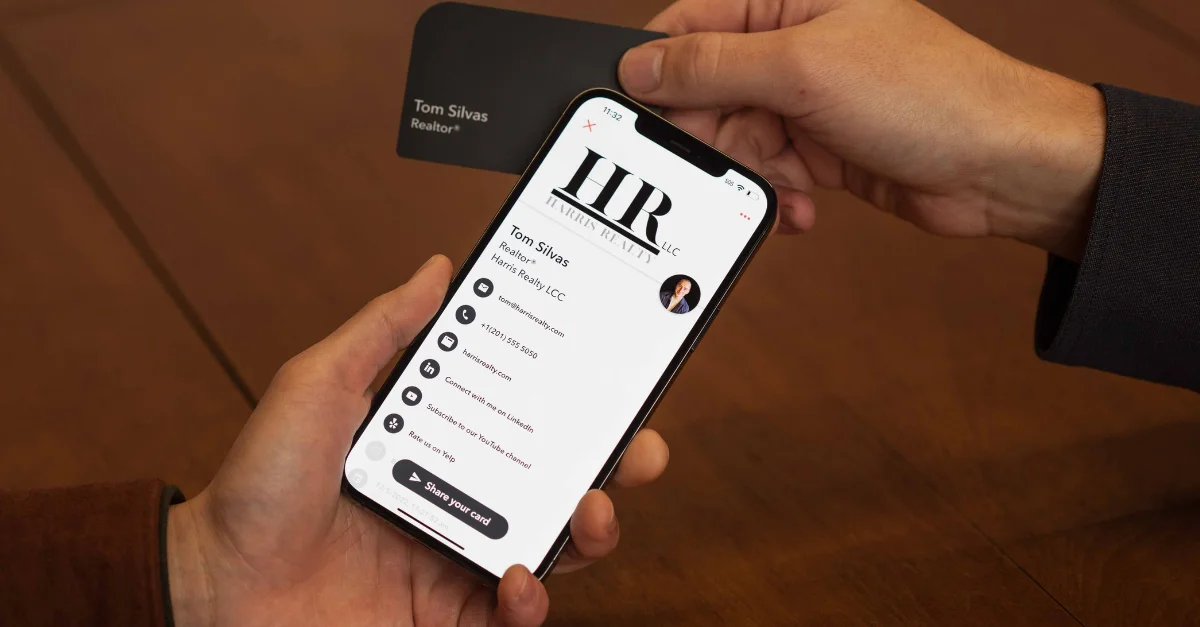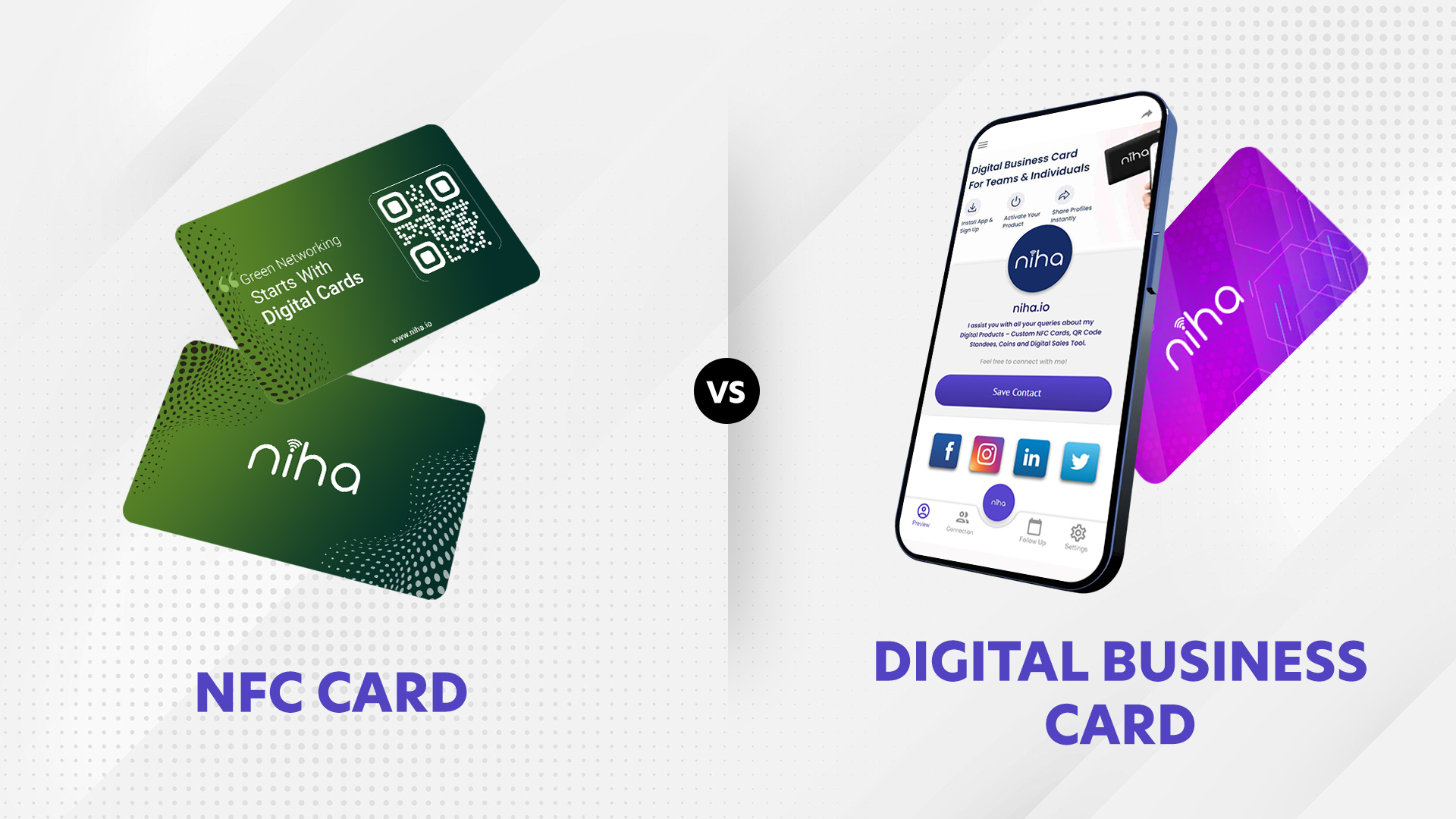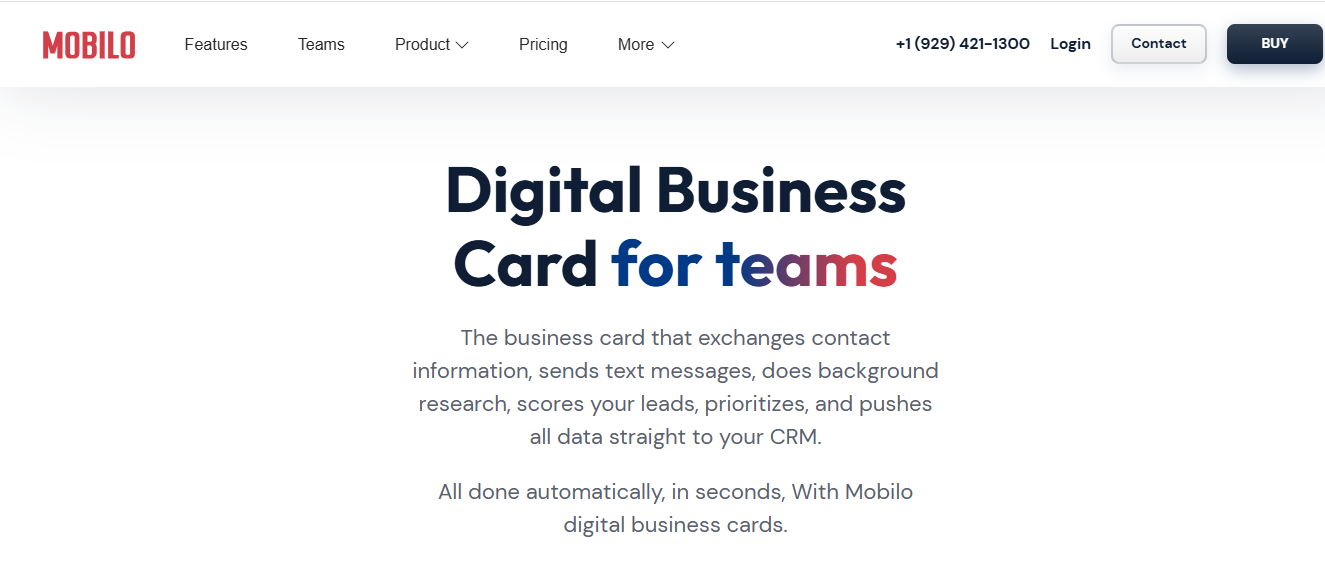.svg)
.png)
NFC business cards make that possible, like a contactless tap sends your details to a phone, cutting the fuss and the paper pile. Many people have concerns about the safety of NFC Business Cards, worrying about privacy, hacking, cloning, or leaking business credentials. This article addresses these security and data protection concerns, explaining how to use NFC cards to share contact information quickly and professionally without compromising personal or business data.
Mobilo's digital business card provides a straightforward, privacy-focused way to share your details with secure NFC tags and easy controls, allowing you to tap to connect confidently and maintain control over who sees your information.

NFC business cards are inherently safe in most everyday situations because the chip is passive and the transmission range is limited to a few centimeters. Safety ultimately depends on how you configure and govern the card, as well as the links it points to. With sensible controls, encrypted payloads, authenticated management, and remote disabling, the technology poses low direct fraud risk while still demanding careful operational planning.
Radio range matters more than hype. NFC works at a few centimeters, so an opportunistic scan requires being very close. That short range explains why many attacks are impractical, and it is also why interest in proximity risks grew in 2023, as shown by Tapt Blog.
28% of users seek more information about NFC safety due to proximity risks, which signals how visible and personal this threat feels to users. Practically, unauthorized scanning is unlikely on a subway bench unless an attacker gets uncomfortably close, but you should still avoid tapping cards against unknown readers.
Not always. A typical tradeoff in cheap hardware is simplicity over cryptographic protection, which is why many passive NFC tags ship with minimal or no encryption. When encryption exists, it is usually limited by the tag’s processing power and cost envelope.
If you require enterprise-level assurance, need tokens that support authenticated updates and server-side encryption, and insist on HTTPS endpoints for any URL the card exposes, then this solution is for you. That turns a static card into a manageable asset, where changes are audited and tamper attempts are visible.
Yes, that is a real risk. NFC cards typically forward a tap to a URL or vCard, and a malicious redirect can lead someone to a phishing page, a drive-by download, or a script that exploits a phone’s vulnerabilities.
The attack depends less on the radio itself and more on the destination to which you point the tap, which is why link hygiene matters. Consistently deliver content through secure, short-lived links, validate domains server-side, and use content negotiation that forces a consent notice before any download or credential request.
When we audit deployments, the failure mode we observe is the exploitation of device vulnerabilities after a tap, rather than the NFC radio directly stealing data. If a card points to an unsafe site that triggers an exploit chain, an attacker can pivot to the user’s device and then to enterprise resources the device has access to. Patching devices, utilizing mobile threat defense, and avoiding deep internal resources without re-authentication significantly reduce the attack surface.
Loss turns a physical token into a potential vector unless you layer controls. Lost cards that are static and never expire remain helpful to an attacker. Practical measures include short-lived links, remote deactivation, and tying updates to SSO or provisioning systems, allowing cards to be revoked centrally. Without those, a misplaced card becomes an instant liability.
Most teams distribute cards in the same way they distribute printed cards because it is familiar and low-friction, which works well at a small scale. As corporations deploy hundreds or thousands of cards, tracking ownership, revoking access, rotating destinations, and proving auditability become expensive and error-prone.
Platforms that require SSO provisioning, maintain role-based access, and produce audit logs resolve those growing pains, allowing IT to treat cards like any other governed identity asset rather than an untracked marketing prop.
Data collection from taps can produce an engagement footprint that includes timestamps, location markers, and device metadata, which raises concerns about consent and compliance with regulations.
If taps are tied to unique identifiers, the activity can be stitched together to profile movements across events. Transparent opt-ins, minimal retention policies, and the ability to anonymize or delete records are crucial for establishing trust and ensuring compliance.
Use authenticated provisioning and server-side link management so the tag stores only an unsigned pointer, and updates require a credentialed session. Multi-party approval workflows and signed firmware for writable tags further reduce the chance that someone can rewrite card content without detection. These controls transform a passive tag into a managed object that IT can secure and monitor.
If you are planning a rollout, you will likely ask questions about what happens when an employee leaves, how to distribute cards to a remote team, and how to track changes. This is where governance matters. Require identity-based provisioning, make remote disabling a standard, and insist on integration with your CRM or MDM so that taps create verifiable, auditable events rather than uncontrolled data leaks.

Digital business cards are the safer, more scalable default for most teams. In contrast, NFC cards remain a valuable physical touchpoint when a tangible handoff and measurable in-person engagement are needed. Choose digital-first for privacy, ease of distribution, and long-term cost control, and reserve NFC as a governed, auditable complement when events or brand presence demand a physical object.
Security is where priorities split. Physical NFC cards create a single point of concern, including lost inventory, lingering active tags, and uncertain hygiene of the recipient device. This concern is genuine, as 70% of NFC card users express concerns about data breaches.
Implementing strict admin controls, short-lived URLs, and instant revocation turns an NFC deployment from a liability into a controlled endpoint. By contrast, fully virtual cards enable you to centralize access, enforce SSO, rotate credentials, and audit every share; it's no surprise, then, that 85% of digital business card users report feeling more secure with their information.
Digital cards excel in reach, as you can send them ahead of a meeting, attach them to calendar invites, or publish them across various channels without requiring physical handling. NFC shines in a moment of theatre, when a tap creates a memorable exchange and boosts conversion tracking at events
A physical card requires inventory, distribution, and replacement cycles; a digital card necessitates user adoption and straightforward sharing flows that work across iOS and Android.
Expect different user journeys. Digital cards reduce friction for recipients who prefer wallet passes, QR scans, or links saved directly to contacts. NFC can feel slick in person, but it breaks down when the card is forgotten, damaged, or the recipient hesitates to tap due to privacy concerns.
In pilots conducted over four weeks across mid-market sales teams, sharing rates increased when teams offered both a wallet pass and a quick URL, as different individuals prefer different contact methods.
Think in total cost of ownership, not unit price. NFC cards incur upfront manufacturing expenses and ongoing logistics costs. Digital-only approaches convert those fixed costs into subscription and management fees, which scale more predictably and let you roll out changes instantly.
Also factor in measurable ROI, including digital cards that integrate with CRM, deliver leads directly into pipelines, turning each share into a quantifiable opportunity rather than a stack of untracked paper.
A physical card has a production and disposal footprint that repeats with each reprint. Virtual cards remove that repetitive cycle and allow continuous content updates without waste. That matters for teams who track ESG metrics or want to avoid the hidden cost of replacing outdated or reclaimed cards.
Most teams handle physical cards through procurement and chance, which works until growth multiplies failure modes. As headcount or event volume rises, issues compound, such as inconsistent brand profiles, outdated contact information, and unrevoked cards, which create compliance risks and poor recipient experiences.
Platforms like Mobilo change that pattern. They maintain the familiar touchpoint while introducing centralized provisioning, role-based permissions, instant deactivation, SOC 2 Type II controls, and CRM connectors, thereby reducing the overhead that previously inflated daily operations.
If your job relies on repeat, in-person rituals where a physical object reinforces trust, consider using NFC as a governed adjunct to a digital identity. If you need broad distribution, rapid updates, privacy assurances, and the lowest marginal cost per share, go fully digital.
If you must have both, design them to complement each other. Use virtual cards for everyday sharing and reserve NFC for controlled events where you can enforce governance and measure impact.
.jpeg)
NFC business cards are safe when you adopt clear operational habits, strong access controls, and predictable lifecycle rules. Treat them like any managed endpoint. Lock down who can change what, run short-lived links, log every action, and train people to follow simple verification steps.
Always route tag payloads through server-side redirects that you control, and require HTTPS with valid certificates. Use an allow-list of approved domains and automated URL-health checks that scan for phishing indicators before a link is handed out at scale.
Add certificate pinning or a short-lived TLS cert policy for pages that require authentication, and configure HSTS so browsers refuse insecure fallbacks. For event kiosks or shared readers, display an on-screen origin and a short, human-readable confirmation so recipients can verify they are connecting to the correct brand.
Disable NFC on devices when not using cards and insist on an explicit consent screen before any exchange, so taps feel deliberate rather than accidental. Treat sharing behavior like other safety routines. Teach representatives to confirm the recipient and verify the visible landing URL before saving any contact, as consistent micro-habits reduce mistakes.
Small behavioral guards have an outsized effect, as shown by the way simple rules cut risk in other fields, according to the CDOT Driver Behavior Report. Using hands-free devices can reduce the risk of accidents by 30%, highlighting the importance of repeatable actions.
Grant companion apps only the permissions they need, and then regularly audit those permissions. Deny background location, contact list write access, and unnecessary sensors unless you can justify them with a traceable business need.
Enforce SSO with conditional access, allowing you to revoke access through identity providers, rotate API keys on a schedule, and protect webhooks with HMAC signatures. Map every integration to a data flow diagram and tag each connector with an owner, retention window, and risk rating so audits are quick and precise.
NFC business cards are safe when you treat them like any other external access point: enforce simple habits, pick providers that support enterprise controls, and bake auditing into every rollout. Do those three things, and you convert a tactile handshake into a verifiable, low-friction lead event, rather than an untracked risk.
When you leave NFC enabled, you increase the chance of events that require resolution later. Flip the NFC toggle off after an exchange, or use device-level controls that only enable NFC while an app is foregrounded.
Think of this as a behavior change that eliminates nuisance taps before they become security headaches, the same logic behind safety habits that reduce exposure in other domains, as shown by the CDOT Driver Behavior Report. Using hands-free devices can reduce the risk of accidents by 30%, highlighting how small, repeatable actions can lower everyday risk.
Train teams to treat every tap like a link preview. Request a visible domain confirmation, insist on consent screens before downloads or credential prompts, and utilize server-side redirects that direct users to a short landing page with clear branding and an explicit 'accept' button.
Configure tags to point to short-lived, auditable URLs so a compromised tag cannot remain useful for long. Utilize mobile browser controls and link scanners in your event toolkit, allowing reps to confirm a destination in under five seconds.
Grant the least privilege needed. A trustworthy companion app requires NFC and network access, and nothing more, unless there is an apparent business reason.
If an app requests location, contacts, or excessive background privileges, deny them or request an enterprise-grade justification. Log approvals centrally so that each permission change is auditable, and require SSO for admin-level access, allowing IT to revoke rights when roles change quickly.
Look for vendors that publish security whitepapers, maintain independent compliance like SOC 2 Type II, offer SSO and provisioning, and provide remote deactivation and audit logs. Demand clear data retention policies, exportable audit trails for CRM handoffs, and signed firmware for writable tags. Those capabilities turn a physical token into a managed identity, not a one-off marketing trinket.
Adopt layered protection, not a single fix. Use short-lived URLs, sign all writable tag updates, require reauthentication for admin changes, and enable automated item revocation tied to HR systems. Treat cards like digital badges or API keys, like revoke them quickly, rotate them regularly, and log every operation so you can reconstruct events.
Layered defenses reduce the likelihood of a minor incident escalating into a significant breach, much like safety layers that prevent worst-case outcomes. For instance, the CDOT Driver Behavior Report illustrates that wearing seatbelts reduces the risk of fatal injury by 45%, demonstrating the effectiveness of physical safety measures.
Collect only what you need and make opt-in explicit at the moment of capture. Avoid using persistent unique identifiers unless they are essential for lead routing, and anonymize or delete contact metadata as soon as it has served its business purpose. Provide easy exports and deletion on request, allowing legal and sales teams to demonstrate compliance without a heavy engineering lift.
Track inventory with serial numbers and QR fallbacks tied to a management console that can revoke a card instantly when someone leaves, loses a device, or a badge is compromised. Pair physical protections, like tamper-evident sleeves and printed card IDs, with automated backend controls that rotate links and disable endpoints on a single click. Run deprovisioning playbooks that link HR offboarding, access revocation, and CRM cleanup to prevent stale profiles from persisting in pipelines.
Run a phased pilot across two distinct contexts for 4 to 8 weeks, for example, inside sales and field events, and define clear acceptance criteria. Average shares per rep, time to deprovision, and any unauthorized redirects detected.
Include a simulated compromise test where you deliberately disable a card and measure response time, and run a tabletop incident with legal, IT, and sales to practice communication and data subject request handling. Track metrics in your CRM to quantify lead capture and correlate any security events with behavioral changes.
Automate alerts for suspicious redirects, unusual tap volumes, or rapid link-follow spikes, and tie those alerts to a response playbook that can quarantine a tag, force link rotation, and notify affected contacts. Keep an audit trail that records who edited content, when a link was rotated, and which identity performed deprovisioning. Test the complete chain quarterly, because tools can fail, but rehearsed responses do not.
Staying within guardrails prevents a minor compromise from escalating into a widespread outage, which reflects the same practical safety logic as obeying speed limits in shared spaces. According to the findings of the CDOT Driver Behavior Report, drivers who adhere to speed limits reduce their risk of crashes by 40%.

We get it, handing someone a paper card still feels quick and human, but when 90% of business contacts never make it into your CRM, that familiar habit is quietly bleeding your pipeline. Join over 59,000 companies who’ve made the switch to Mobilo to capture measurable, CRM-ready leads and generate 10x more results at events; book a demo and claim your first 25 Cards Free.